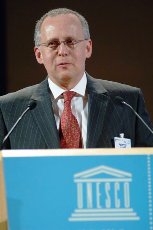
As Tony Blair attempts to sort out the Middle East, George Bush prepares to leave office, the Bicentenary comes to a close and the UN International Year of Planet Earth is launched, the word on everyone’s lips is “legacy”, says Ted Nield
Geoscientist 18.4 April 2008
Everyone likes a good legacy; but the complex events that eventually throw every ship of state off course mean that, having inevitably failed to achieve what they intended, politicians faced with retirement begin searching the broom cupboard for something for which they would prefer to be remembered. Forget Abu Ghraib. How much better, for example, to be remembered for the President’s Emergency Plan for Aids Relief (which, despite being undermined by the evangelistic far right in setting its delivery agenda, has done much good in Africa)? You really can’t blame a man for trying.
Others, happily, don’t have to search so hard for a satisfying legacy project to feel proud of. From the beginning, the Society Bicentenary Steering Committee felt that, although having a good time and sending out signals to generate warm feelings were important, they were not enough; something less ephemeral had also to come out of it – and so it did. As the Annual Report 2007 will show, when you receive it with your May issue,– projects like the Lyell Collection, its global reach made greater still by the free access granted to institutions in developing countries, will stand for many years in grateful memory of the Bicentenary, the Society, and of its sponsors Shell, BP and Schlumberger.
As geologists should be the first to know, duration is at best a relative concept. Material things enjoy very little duration on Earth; while schools materials, books, scientific papers, even great ideas themselves, are all eventually superseded. But the anxiety that drives the need for lasting legacies is not that hard to understand – especially among scientists. I have observed that the quest for permanence is keenly felt among scientists - and have written elsewhere about how scientists like to feel that their contributions are permanent bricks in the walls of a great communal edifice - much like a termite might view its gobbets of mud.
By contrast, those of us in the performing arts (actors, jugglers, journalists, PR people, and for a few moments at least, 150 students from all over the world at the global launch of the International Year (picture)) know that tomorrow it’s all there to be done again – and we don’t mind at all. More mayflies than termites, we are often surprised to find that scientists thrust before the cameras are often impatient with the notion that an article in a paper or a day of good coverage are by themselves enough. For they realise that tomorrow, all the work that they put in will be so much chip-wrapping, and it will all be there to be done again. No legacy, they think.
Yet surely the most lasting of all legacies are those that affect human feeling and behaviour - where communication is king. For feeling and behaviour are the very stuff of cultural evolution, the Lamarckian process that makes human evolution unique in life’s three-point-something billion years. Like reeds in the wind, such intangible things survive best the onslaught of time because they are renewed as they are handed on. The longest legacy that the International Year of Planet Earth – or the Bicentenary, or anyone – can hope for is to live on - unremarked maybe, but indelible nonetheless - in the hearts and minds of generations to come.